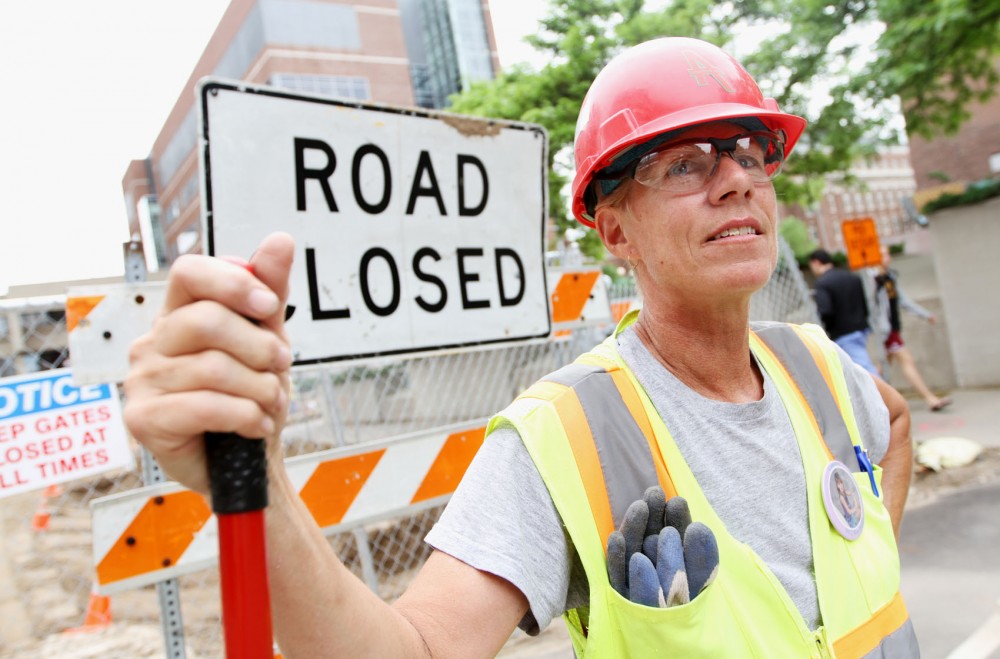With light-rail construction engulfing the University of Minnesota, campus is covered in hard hats and neon vests. But few of those are worn by female workers.
Women have joined the construction industry as laborers, engineers and managers, but the field is still largely dominated by men.
“We’re still a minority, but not as much as we used to be,” said light-rail construction worker Jenellen Gallatin, who has been working in construction for 12 years.
“I like physical work, so for me, it works,” she said.
In Minneapolis, 17.6 percent of light-rail workers are minorities, and 6.3 percent are female, with some individuals factoring into both percentages. These numbers are near the project goal of employing 18 percent minority and 6 percent female workers.
Christine Beckwith, a graduate of the University, is the deputy project director for the light-rail project at the Metropolitan Council. She is the highest-ranking woman on the project as one of the top four officials in the project office.
“I remember going to pre-construction meetings and running the meetings and people being kind of surprised at my role on it,” she said. “They just thought I was there to take notes or something.”
Overall, though, she and other female workers said they don’t face discrimination.
“I’ve never had a problem with any of the guys,” Gallatin said.
Because construction began as, and is, a male-dominated profession, Gallatin said women going into the field can’t be sensitive to the atmosphere.
“If you can’t handle it, get out. This is their field.”
In 2009, the U.S. Bureau of Labor Statistics reported that women in construction were “substantially underrepresented.”
In 2010, women comprised approximately 9 percent of workers in the construction industry, according to the National Association of Women in Construction. This includes all occupation sectors in construction, like sales and office jobs where women made up 76 percent of the sector.
Lisa Becker, a laborer in construction for 13 years, said, “Along the way there’s a few glitches, but those get resolved pretty quickly.”
Becker became the first female labor foreman at her previous job at Prairie Island Nuclear Power Plant in Red Wing, Minn.
“There was some peacocking about that at first,” she said. “It was just the fact that I got picked over the boys.”
All the women interviewed for this story said workers have to prove themselves in the field regardless of gender.
“If you go from one place to the next place to the next place, you [got to] start all over at square one and let them know that you’re not an idiot; you know the right end of the wrench to pull,” Becker said.
Early in her career, Beckwith said she was filling up heavy buckets and had to carry them with another female coworker. Workers at the site were making fun of them for not being able to carry the bucket alone.
She thought it was because she was a female, but she said it really was because she was “green.”
“You’re new, they got to tease you about something,” said Kelly Hovde, assistant project manager and field engineer for Meyer Contracting.
Just kidding?
Workers said everyone jokes and teases, and it’s important to know the difference between that and harassment.
“Some people do not pay attention to the nuance of voice, and that’s where they’re thinking it’s derogatory or whatever,” Gallatin said. “But it’s not — they’re joking.”
It’s illegal to harass a woman by making comments about women in general, but the law doesn’t prohibit simple teasing, offhand comments, or isolated incidents that are not very serious, according to the U.S. Equal Employment Opportunity Commission. The line between teasing and harassment, however, can sometimes be difficult to discern.
“I’ve heard of females walking by guys, and they’re telling a joke, and they say it’s sexual harassment,” Gallatin said.
“You should not have that sensitive of a nature if you’re coming into something like that.”
“There’s a difference between by you and at you,” said Justin Dean, a supervisor with Ames/McCrossan Joint Venture — the contractor team building the Minneapolis portion of the light rail.
Despite slight differences in treatment, the women said they enjoy working construction and don’t mind working in a male-dominated profession.
“You have to be assertive,” Beckwith said.

















